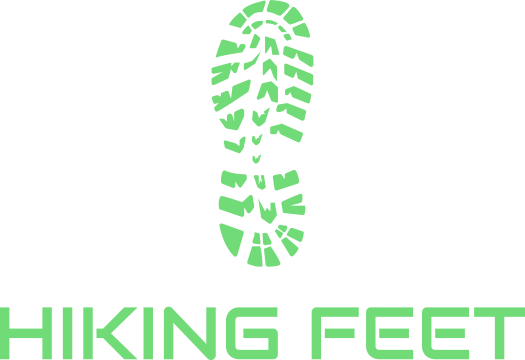Many hikers are confused about how hiking boots should fit. Should you size up or wear your regular shoe size? How much toe space do you need? How do you know if your hiking boots are too big or too small? As someone who used to fit men and women at a hiking and backpacking shop, I'm happy to answer these questions to help you learn how hiking boots and hiking shoes should fit. I'll also illustrate three ways for men and women to fit themselves at home or at the store—and pass along some pro tips for sizing and fitting—so you can buy footwear that fits your hiking feet.
How should hiking boots fit?
Hiking boots should fit snug but not tight in the heel (to prevent heel lift and slippage) with enough room in the forefoot and toe box, so your feet don't feel constricted and your toes can spread out comfortably.
As a general rule, hikers want approximately a half-inch of space between their toes and the tip of their boots/shoes. That's about the width of your finger (men) or thumb (women). This extra space will
- leave room for swelling (feet can swell a half-size or more when hiking)
- allow hikers' toes to spread out naturally for a stronger base
- prevent toes from hitting the ends of boots/shoes on steep descents (which causes injuries)
Yes, most hikers should size up for hiking boots and shoes. In most cases, your hiking size will be a half-size or full-size bigger than your everyday shoe size. However, that's not a hard and fast rule—because fit varies by brand and sometimes within a brand's line up.
For example, my regular shoe size is a men's size 11.5. Here are my hiking sizes for different brands and best-selling hiking boots and shoes:
That's why it's so important to try on several pairs to find the brands, boots, and shoes that fit you best.
Brands have distinctive fits because they develop their own lasts (model feet) to size and shape their hiking footwear. Ultimately, you'll get your best fit from the brand(s) whose last most closely matches the size and contours of your feet.
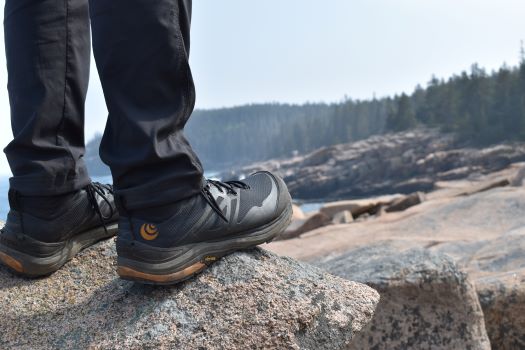
Topo Athletic hiking boots and trail running shoes fit my feet better than other brands
3 methods to fit hiking boots/shoes
The best way to buy hiking footwear that fits is to visit an outdoor specialty retailer (not a sporting goods chain), so outdoor industry pros can fit you and recommend which boots/shoes might fit your feet and match your hikes. If that option isn't available to you, here are three methods you can try at home or at the store to determine your best fit:
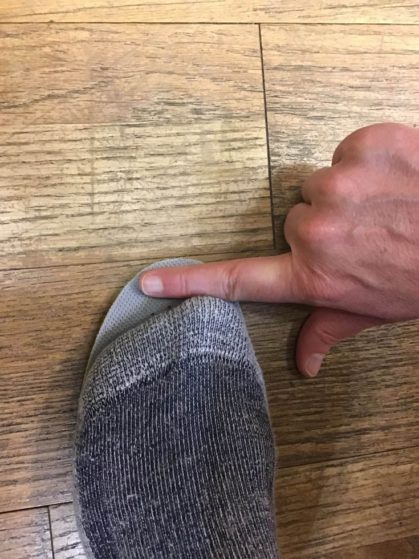
half-inch between the longest toe and end of the insole
fitting method #1: stand on the insoles
For me, the best way to fit hiking boots or hiking shoes is to remove the insoles, place them on the floor, and stand on them. Stand directly over the insole and make sure your foot is seated properly in the heel cup before checking for sizing. Here's what you're looking for to get a good hiking fit:
- Length: Use your pointer finger (men) or thumb (women) to gauge 1/2-inch clearance from the tip of your toes to the front edge of the insole.
- Width: Ideally, the insole will more or less trace around the contours of your feet. However, if the outside of your foot is hanging over the edge of the insole, you need a wider boot or shoe. If you can see a lot of insole along the edges of your feet, you probably need a narrower fit.
It's hard to feel where feet sit inside of a stiff hiking boot or hiking shoes. In contrast, standing on the insoles lets you see how, exactly, your feet will fit inside a specific hiking boot, hiking shoe, or trail running shoe. Once a boot or shoe has passed this pre-test, you're clear to put the insole back in, slip it on, tighten the laces, and give it an indoor test ride.
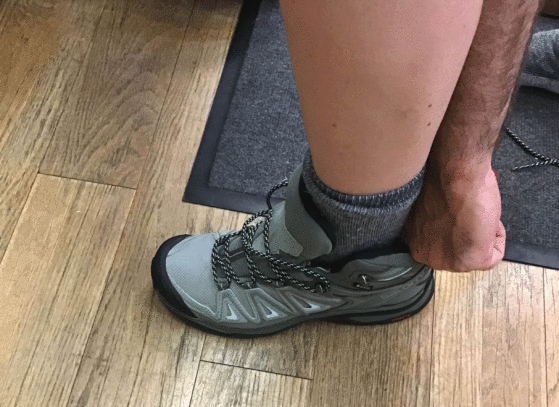
Fitting method #2: the one-finger test
Similar to ski boot fittings, you and a friend can also fit hiking boots with an easy finger test. First, completely loosen all the laces. Then, slide your foot forward until your longest toe touches the tip of the boot or shoe. Now, have your partner try to slide a finger behind your heel (which may be a little awkward). If there's room for one finger to squeeze in behind your heel, you probably have a good length for hiking. You need a larger size if one finger doesn't fit—and a smaller size if more than one finger fits behind your heel.
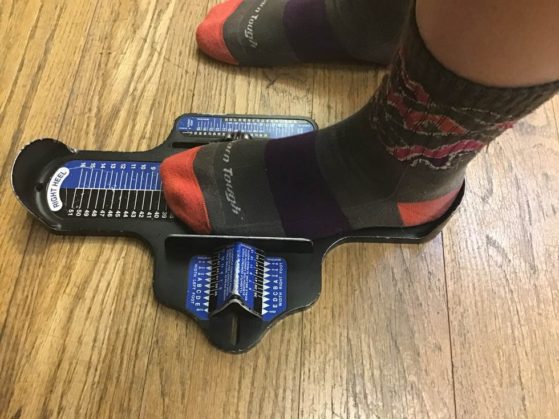
Fitting method #3: Brannock device
You can also estimate your shoe size with an old-school Brannock device. The Brannock device will give you three measurements for each of your feet: (1) heel to toe measurement, (2) heel to ball of foot measurement, (3) width measurement. (Here's how to use the Brannock device.) You should stand & measure both feet—it's not unusual to have a larger foot.
- With healthy feet, your shoe size should be pretty consistent across measurements. In most cases, you'll want to size up at least a half size for hiking. (i.e. If your feet are size 9 on a Brannock device, start with size 9.5...)
- If your heel-to-toe and heel-to-ball measurements are different, your feet may be harder to fit. Most of the time, it's best to go with whichever measurement is larger. However, if there's a big size discrepancy, you may need to experiment to find the right length and flex point for your feet.
The Brannock device is a dated dress shoe technology that has little if anything to do with how brands actually size and shape their footwear. However, it provides an okay estimate if you haven't been fitted in awhile or suspect you've been wearing the wrong size.
Pro tips: how to buy hiking boots that fit
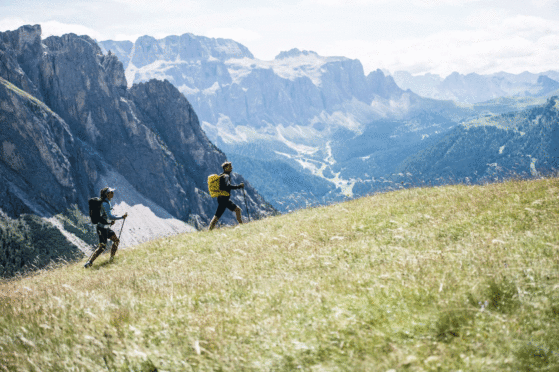
La Sportiva is a good brand for hikers with narrow feet
Here are a few more pro tips to help you buy hiking boots and shoes that actually fit you:
Smart sizing and fitting
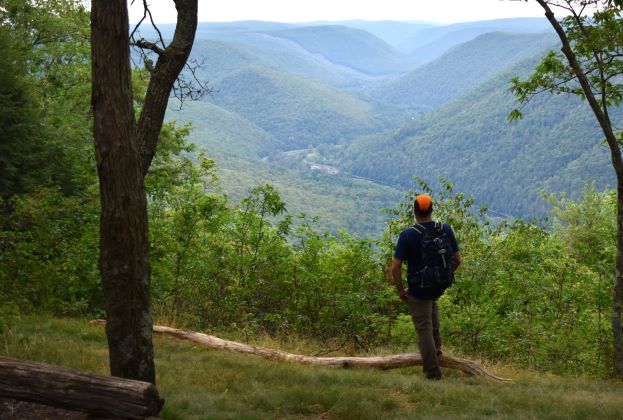
hiking is safer and more enjoyable when you buy hiking boots/shoes that fit
Are you feeling smarter about fit now? Your hiking feet will thank you if you try out these fitting methods and pro tips when you're ready to buy your next pair of hiking boots, hiking shoes, or trail running shoes. They've helped me nail my fit for several years now, and many of my customers have thanked me for helping them find their perfect fits, too. Let me know in the comments below if this post has helped you. Or feel free to share your tips and tricks for nailing your hiking boot fit.
Thanks for checking out Hiking Feet. And Happy hiking!Faqs
As a rule of thumb, hikers should size up a half-size or full-size from their everyday shoe size. The right size depends on the brand and the fit of specific hiking boots/shoes. You want whichever size gives you approximately a 1/2 inch between your longest toe and the tip of your shoe—and a boot that flexes where your feet naturally flex.
Hikers need approximately a half-inch of space between their toes and the tips of their boots/shoes. That's approximately the width of your pointer finger (men) or thumb (women).
No, hikers can suffer toe and foot injuries if their toes touch the end of their hiking boots and shoes, ranging from blisters and lost tail nails to bunions, stubbed and broken toes, and structural foot injuries. That's why hikers want a 1/2-inch of space in the toe box and size up a 1/2 size or full size from their regular shoe size.
If your hiking boots/shoes are too big, you may notice your feet sliding around in your shoes, which may lead to blisters on the bottoms or sides of your feet. If your hiking boots are too small, you may notice your toes hitting the ends of your footwear on steep descents, experience blisters between your toes or on the tips of your toes, feel pressure on the top of your feet, feel pressure on your pinky toe, and/or feel the sides of your shoes squeezing the outsides of your feet, especially on longer or harder hikes.
Hikers with wide feet should target brands with wider lasts, such as Merrell, KEEN, Altra, and Topo Athletic, or brands that offer their best sellers in wide sizes. Here are my recommendations for the best hiking boots for wide feet, the best hiking shoes for wide feet, best hiking boots with wide toe boxes, and best hiking shoes with wide toe boxes.
Hikers with narrow feet should target European brands, especially Italian brands, which generally have narrower fits than US brands. For specific recommendations, check out my curated lists of the best hiking boots for narrow feet or best hiking shoes for narrow feet.
Most hikers should be able to avoid this choice by trying another brand or choosing a different hiking hoot/shoe. However, if you're in between sizes, it's best to size up. If your feet are different sizes, it's generally best to buy whatever boot/shoe best fits your larger foot.
